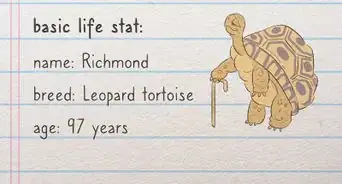This article was co-authored by Christopher Taylor, PhD. Christopher Taylor is an Adjunct Assistant Professor of English at Austin Community College in Texas. He received his PhD in English Literature and Medieval Studies from the University of Texas at Austin in 2014.
There are 9 references cited in this article, which can be found at the bottom of the page.
This article has been viewed 33,834 times.
At the heart of every story is the protagonist. The protagonist is responsible for experiencing the events that happen throughout the story and interpreting these events in a meaningful way for the reader.[1] Creating a successful protagonist is no easy task, but if you want to write a great story, it is essential that you first create a believable, dynamic protagonist that the reader finds relatable.
Steps
Developing Dynamic Characters
-
1Craft your story idea. Coming up with a well-thought-out premise for your story will give you the basis upon which to develop your characters, including your protagonist. In order to know how your characters will develop, what qualities they will have, and how they might change throughout your novel, you need to have a clear idea where your story is headed. When you’re finished, you should compile your thoughts into two or three sentences that give a synopsis of your plot. As you develop your premise, ask yourself:
- Which character is the protagonist?
- What is the protagonist like at the beginning and how might that change after they face conflict throughout the story?
- What is the protagonist’s objective?
- What's their motivation?
- What do they want?
- What do they fear?
- What or who will stand in the way of them achieving this objective?
- What struggles will the protagonist face trying to accomplish their objective?
- What is the result of the protagonist’s actions?[2]
-
2Get to know your characters. You will need to know the characters in your story inside and out so that you can be consistent in their choices and reactions. This might seem daunting, but there are strategies to help you complete this task:
- Create a character sheet for each of your characters. Give more detail for major characters, rather than minor characters.
- For major characters, work backwards from the time they are first engaged in the plot, or when they face their first conflict or decision. Ask yourself:
- What events have led them to be involved at this point in the plot?
- What life experiences have shaped their reactions?
- Did they do something to cause this event to happen?
- How will they move forward?
- Perform an “interview” of your characters to unveil the intricate details of their life. In addition to hashing out their physical appearance, dig further into their persona by asking questions that will develop their beliefs and values.
- For example, ask questions like, “Do they believe in God?” and “What moments have shaped their life most significantly?”[3]
Advertisement -
3Develop characters that feel like real people. Ultimately, you want your readers to become invested in your characters. They must be able to relate to them on a personal level. To help your readers relate, create characters that feel like real people and have qualities consistent with this idea.
- When you’re developing your characters, consider their backstory, physical description, and how they speak.
- Think about their goals, strengths, weaknesses, and fears and what qualities and quirks they have that make them unique.
- Know what they do and don't understand about the events in your story, their world, or life in general. Remember, no one knows everything.
- Make choices for your characters that are consistent with the details you’ve uncovered. For instance, their name must embody their persona.[4]
-
4Show how your characters interact. To make your characters believable, demonstrate their persona through their interactions with other characters. After all, we all have relationships in our lives and your characters are no different.
- Explain what your characters are thinking about the other characters. Don’t assume your reader already knows.
- Allow you characters to challenge their own thinking. For example, instead of simply stating they hate another character, have them question why they hate this person.[5]
- The best characters not only relate to the world around them, but also to the other characters in the story.[6]
-
5Make sure your protagonist undergoes a change. A dynamic character grows and changes as a result of the story. The events of your story should have some meaning for your protagonist. Depending on your genre and story concept, the change could be minimal or dramatic. It could also be physical or emotional.[7]
- Your character might learn a lesson, gain battle wounds, or realize something within themselves. How they change should make sense for your character and the story as a whole.
Creating a Believable Protagonist
-
1Give your protagonist a difficult problem. Your protagonist is the person driving your story. Their dilemma must be central to the plot and they should be the only character capable of solving this problem, or at least the character most capable of solving it.[8] Examples of problems a protagonist might face include:
- Completing a mission
- Saving a loved one who is in trouble
- Answering a question about their past
-
2Give them motivation. Your protagonist must have an internal reason to take risks and make tough decisions. Make their motivation something that every reader can relate to, like an everyday want, hope, or fear.
- For example, the need to be loved or accepted is a motivation to which readers can relate.
- Whatever is driving the protagonist should be clear to the reader. Your reader should gain a better understanding of the protagonist with each struggle they face.[9]
-
3Make the protagonist struggle to get what they want and perhaps fail. Your protagonist needs to be relatable to every reader so create a character who is unlikely to succeed in achieving their goal. A protagonist that is good at everything and likely to succeed is uninteresting and hard for most people to identify with. If your character gets what they want, they should strive and sacrifice to get there. It's also okay for your protagonist to fail.
- A great example is Frodo from The Lord of the Rings. Frodo is an unassuming hobbit who is small in stature but not in heart. His success seems unlikely, making his journey all the more interesting to the reader.[10]
-
4Ensure the protagonist connects with the reader. In general, your reader should feel sympathy or empathy for the protagonist. This means they can see similarities between the struggles faced by the protagonist and those they’ve experienced in their own lives.
- Make your protagonist somewhat flawed because real people are flawed and imperfect.
- Use your own connection to the protagonist to guide their quest and determine how the reader might connect to them.[11]
Empowering the Protagonist through Your Writing
-
1Ensure the protagonist is capable of making decisions. The fate of your protagonist should be in their own hands throughout your story. This character should be the one making decisions and dealing with the consequences. Keep in mind:
- Your protagonist doesn’t have to choose their fate right away. Allowing them to waiver in their decisions throughout the book can create an interesting read.
- If they aren’t making decisions that affect their fate, they are not the protagonist, but merely a background character.[12]
-
2Give them the capacity to change. Though the protagonist doesn’t necessarily have to change throughout the novel, a good protagonist will be given the opportunity to do so.[13] The protagonist can effect change in several different ways:
-
3Create a strong antagonist. Your antagonist is there to create conflict and push your protagonist to question their decisions throughout your story. In the end, a strongly characterized antagonist will make your protagonist look even better when they win. Keep the following in mind when developing your antagonist:
- They should be the opposite of your protagonist—a mirror image.
- They are not necessarily a villain or someone evil. The personality embodied by the antagonist will directly relate to that of the protagonist.[17]
Expert Q&A
-
QuestionI want to write a story where the protagonist goes on a quest to find a cure and is betrayed by a close friend at the end of the story. What sort of personality should the antagonist have?
 Christopher Taylor, PhDChristopher Taylor is an Adjunct Assistant Professor of English at Austin Community College in Texas. He received his PhD in English Literature and Medieval Studies from the University of Texas at Austin in 2014.
Christopher Taylor, PhDChristopher Taylor is an Adjunct Assistant Professor of English at Austin Community College in Texas. He received his PhD in English Literature and Medieval Studies from the University of Texas at Austin in 2014.
English Professor Your antagonist should have similar traits to your protagonist but also a few clear differences that the reader can recognize. Don't make them polar opposites. Instead, a good antagonist could have been in the same position as the protagonist, if it weren't for a critical part of their personality or a difficult backstory.
Your antagonist should have similar traits to your protagonist but also a few clear differences that the reader can recognize. Don't make them polar opposites. Instead, a good antagonist could have been in the same position as the protagonist, if it weren't for a critical part of their personality or a difficult backstory. -
QuestionI'm writing a book with civil war-like elements and the protagonist isn't the hero, instead she's just someone fighting for her rights. Is that okay?
 Rajeena RebaCommunity AnswerIf you think that is a good enough plot for your book, then it is okay. Perfectly fine. Having your protagonist not be the hero is a great way to avoid a Mary-Sue character. Mix and match anything into your story, after all, it is yours. And it is perfectly okay to have the protagonist do what she does, if fighting for her rights is her conflict, let it be a worthwhile fight!
Rajeena RebaCommunity AnswerIf you think that is a good enough plot for your book, then it is okay. Perfectly fine. Having your protagonist not be the hero is a great way to avoid a Mary-Sue character. Mix and match anything into your story, after all, it is yours. And it is perfectly okay to have the protagonist do what she does, if fighting for her rights is her conflict, let it be a worthwhile fight! -
QuestionHow many protagonists can a story have?
 Community AnswerThe best stories usually have a small number of protagonists so that you can fully flesh out each one. Having too many protagonists can make your story difficult to follow.
Community AnswerThe best stories usually have a small number of protagonists so that you can fully flesh out each one. Having too many protagonists can make your story difficult to follow.
Warnings
- Don't leave plot holes in the protagonist's story. If there is a time-skip, make sure to fill in what happened then.⧼thumbs_response⧽
- Don't overdo the protagonist's backstory. It doesn't need to include useless information that won't be used later on in the story⧼thumbs_response⧽
References
- ↑ http://www.writersdigest.com/editor-blogs/there-are-no-rules/how-to-create-a-successful-protagonist
- ↑ http://www.writersdigest.com/online-editor/7-steps-to-creating-a-flexible-outline-for-any-story
- ↑ http://www.writersdigest.com/online-editor/7-steps-to-creating-a-flexible-outline-for-any-story
- ↑ https://www.writingforward.com/storytelling/12-character-writing-tips-for-fiction-writers
- ↑ http://www.writersdigest.com/writing-articles/by-writing-goal/improve-my-writing/8-ways-to-write-better-characters
- ↑ http://www.writersdigest.com/writing-articles/by-writing-goal/improve-my-writing/8-ways-to-write-better-characters
- ↑ http://www.writersdigest.com/editor-blogs/there-are-no-rules/how-to-create-a-successful-protagonist
- ↑ http://blog.janicehardy.com/2013/06/10-traits-of-great-protagonist.html
- ↑ http://www.writersdigest.com/editor-blogs/there-are-no-rules/how-to-create-a-successful-protagonist
- ↑ http://www.writersdigest.com/editor-blogs/there-are-no-rules/how-to-create-a-successful-protagonist
- ↑ http://www.writersdigest.com/editor-blogs/there-are-no-rules/how-to-create-a-successful-protagonist
- ↑ http://thewritepractice.com/protagonist/
- ↑ http://www.writersdigest.com/editor-blogs/there-are-no-rules/how-to-create-a-successful-protagonist
- ↑ http://www.writersdigest.com/editor-blogs/there-are-no-rules/how-to-create-a-successful-protagonist
- ↑ http://www.writersdigest.com/editor-blogs/there-are-no-rules/how-to-create-a-successful-protagonist
- ↑ http://blog.janicehardy.com/2013/06/10-traits-of-great-protagonist.html
- ↑ http://thewritepractice.com/protagonist/







































































